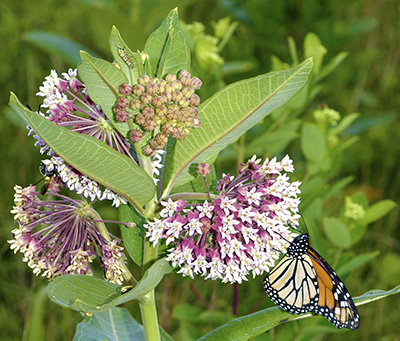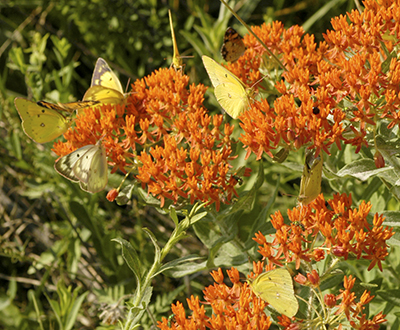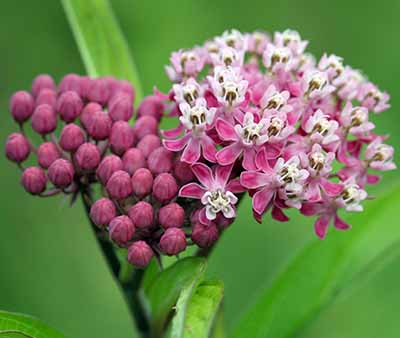How to collect and grow milkweeds to help monarchs and other pollinators
A step-by-step resource to saving seeds and planting milkweed to help monarchs and other pollinators.

Fluffs of white appear along country roads in Michigan every fall – the seed pods of milkweed plants. These little, fluffy seeds hold a lot of potential for monarchs passing through Michigan, and are important to many bees. The beautiful flowers of milkweeds produce pollen and nectar for bees, butterflies and other pollinators. More milkweed in Michigan means more food for pollinators, and more places for monarchs on their migration. Butterflies and bees can use your help in planting more of these plants. Michigan State University Extension offers the followings steps on what you can do.
Grab a friend, bring a kid, put the dog on a leash and go out and collect milkweed seeds! Bring envelopes or baggies and a marker so that each species can be kept separate. Milkweeds grow well in disturbed areas, so scout in ditches, pastures, field edges, medians, etc. (Make sure you get permission before you go on any private land.)
- Look for different types of milkweeds. There are about a dozen types of milkweed that are native to Michigan – you can check out their ranges at the Biota of North America’s Plant Atlas. You can also see what types of milkweed seeds are needed in your region through this map on Monarch Watch.
- Seed pods should be open, dry and brown. If you aren’t sure, give the pod a squeeze – it should pop open easily. If pods are still green or white, keep a note where they are and come back later.
- Grab some seeds from many different plants. Many milkweeds are clonal, meaning plants in a group are closely related. To get lots of diversity, collect seeds from plants in many areas. You can collect a lot from common ones like common milkweed (Asclepis syrica), butterfly weed (Asclepis tuberosa) and swamp milkweed (Asclepis incarnate), but only a little from ones that are rarer.

Common milkweed (Asclepis syrica). Photo by Duke Elser, MSU Extension.

Butterfly weed, also known as butterfly milkweed (Asclepis tuberosa). Photo by Duke Elsner, MSU Extension.

Swamp milkweed (Asclepis incarnate). Photo by David Cappaert, MSU, Bugwood.org.
Older milkweed plants are very difficult to transplant, so we do not recommend transplanting older, large milkweeds.
What do you do with milkweed seeds?
You can plant them immediately this fall. October and November work well in Michigan – you want the soil to be too cold for the seeds to germinate, but not yet frozen. Choose a sunny corner where the milkweeds can spread. Create a patch of bare soil and water it so the soil is moist. Use your finger to poke holes in the soil and drop a seed in each hole. Cover and wait for spring! For more tips on fall planting, see “Fall Planting Milkweed Seeds – 10 Simple Steps!” from Monarch Butterfly Garden.
Miss the window for fall planting? You can winter sow many types of milkweed. Use old, plastic containers like yogurt containers. Poke a few holes in the bottom for drainage and fill with a few inches of potting mix. Dampen the mix and plant the seeds, covering them lightly with more soil. Poke a few holes in the lid and cover your container. Put your container outside in a shady spot, like the north side of your garage. For more tips on winter sown milkweed, see “Winter Sowing Milkweed Seeds Part 2: Prepare Your Containers” from Monarch Butterfly Garden.
You can also plant milkweed in the spring! You have to take care of the seeds to make sure they will be viable for spring planting.
- Remove the fluffy white coma, or the little seed parachutes. You want to only store the little brown seeds. You can remove these by hand or by putting them all in a paper bag and shaking vigorously.
- Make sure your seeds are free from pests. Milkweed bugs can pierce holes in the seeds, ruining them. Make sure there aren’t any insects or extra plant material in with your seeds. See photos of milkweed bugs and get more tips on saving seeds.
- Give your seeds a winter. Milkweed seeds, like many native plants, need to feel a cold winter before they can germinate. This process is called vernalization and can be done many ways. The simplest is to put seeds in moist soil or peat and store in an old refrigerator. If you don’t want soil in your refrigerator, you can also layer seeds between moist paper towels in a baggie in your crisper, keeping them cold for a minimum of three weeks and up to three months.
- Start seeds indoors four to six weeks before transplanting outdoors. Milkweed seeds can be direct sown in spring, but transplants have better success. Fill pots or trays with light, well-drained soil. Add the seeds and cover with 0.25 inches of soil. Keep soil moist and pots in a sunny, warm spot or under grow lights.
- Transplant outdoors. Once the danger of frost has passed and the milkweed starts have four true leaves, they are ready to go outside. Clear a patch in a sunny spot, giving each plant plenty of room to spread its roots. Water frequently until your plants are established.
Not able to collect enough seeds?
You can purchase milkweed seeds and plants at the following places:
- Xerces.org has a milkweed seed finder
- Michigan Native Plant Producers
- Monarch Watch’s Milkweed Market
- Monarch Watch’s List of Vendors
Here is a table of commercially available milkweeds for Michigan.
Commercially available milkweeds for Michigan |
|||
|---|---|---|---|
|
Common name |
Scientific name |
Native range in Michigan |
Available as |
|
Common milkweed |
Asclepias syriaca |
Throughout |
Seed |
|
Butterfly milkweed |
A. tuberosa |
Throughout |
Container plants and seed |
|
Swamp milkweed |
A. incarnata |
Throughout |
Container plants and seed |
|
Whorled milkweed |
A. verticillata |
Southern Lower |
Seed |
|
Tall milkweed |
A. exaltata |
Throughout |
Container plants |
|
Prairie milkweed |
A. sullivantii |
Southern Lower |
Container plants |
Not able to plant milkweed?
Even if you don’t have enough room to plant milkweed, you can help by volunteering for seed collection trips with a local Land Conservancy, or by donating your seeds to other projects that help monarchs. To donate, visit Monarch Watch and view a list of some Michigan Land Conservancy programs.
Register your site as a Monarch Waystation
Show your dedication to monarch conservation by registering your site as a Monarch Waystation. It will show up on the International Monarch Waystation Registry, and you can order a sign to teach your neighbors about monarch conservation. Additional information to certify your waystation, including kits, brochures and information, can be found at Monarch Watch, as well as the applications for Monarch Waystations and a guide to creating a waystation.
More resources on planting milkweed
- Growing Milkweeds by Monarch Watch
- Create Habitat for Monarchs by Monarch Joint Venture
- Finding, Collecting, and Growing Milkweed by University of Minnesota Monarch Lab
- Monarch Watch Milkweed Market
- Milkweed Facts by Xerces Society
- Milkweeds: A Conservation Practitioner’s Guide by Xerces Society



 Print
Print Email
Email